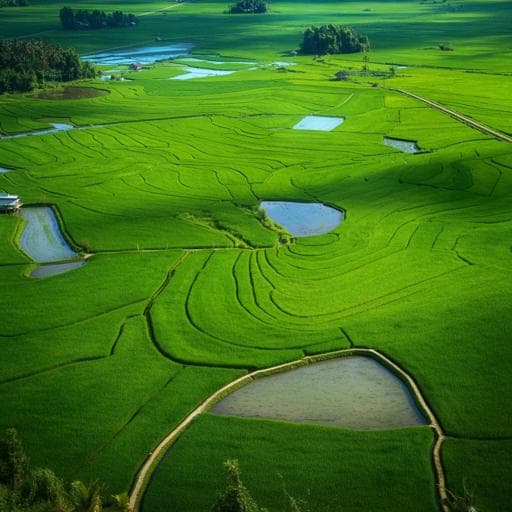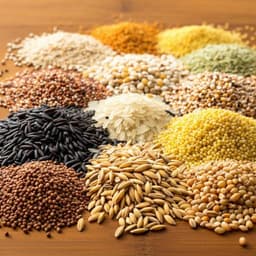
Agriculture
Enhancing rice production sustainability and resilience via reactivating small water bodies for irrigation and drainage
S. Li, Y. Zhuang, et al.
In a groundbreaking study, researchers including Sisi Li and Yanhua Zhuang, highlight how reactivating small water bodies can not only reduce China's rice production water footprint by 30% but also boost irrigation self-sufficiency significantly. Discover how this innovative approach can enhance sustainability in the face of climate challenges.
~3 min • Beginner • English
Introduction
The study addresses how to make rice production more sustainable and resilient to climate change by transforming irrigation-drainage systems. Modern centralized systems reliant on remote reservoirs have expanded irrigated and drained area but largely bypass or disconnect small water bodies, increasing freshwater demand and nutrient-rich wastewater discharge. Agriculture, especially rice, exerts high pressure on freshwater quantity and quality, and climate change intensifies droughts and extreme events that threaten yields. The research explores whether reactivating small water bodies (ditches and ponds) within rice irrigation-drainage units can reduce the water footprint (green, blue, gray components) and enhance system resilience (irrigation self-sufficiency and yield stabilization in dry years) in China.
Literature Review
Prior work has focused on field-level technologies such as water-saving irrigation, controlled drainage, and nutrient management, with less emphasis on system-level redesign. Studies in the Ganges Basin suggest irrigation system transformation can cost-effectively shift water between seasons. Redesigning drainage can mitigate nutrient losses, boost fertilizer efficiency, and reduce greenhouse gas emissions. Resilience literature advocates integrated storage portfolios including reservoirs, ponds, tanks, aquifers, and wetlands. Historically, decentralized pond-based systems (e.g., China’s Beitang) provided local storage and irrigation, nutrient retention, and biodiversity support. However, modern centralized systems have displaced these functions. Existing studies typically address single aspects (resource regulation, water quality, or resilience); comprehensive analyses coupling sustainability and resilience at system scale remain limited, motivating the present work.
Methodology
The authors conducted a national-scale survey of China’s rice irrigation-drainage systems to document historical evolution and current use of small water bodies. Data sources included: (1) national statistics (1950–2020) on Beitang counts, irrigated/drainage area, reservoirs, population, aquaculture ponds, and rice yield; (2) expert knowledge on four irrigation-drainage unit (IDU) management styles (totally centralized, partly decentralized 1, partly decentralized 2, quasi-decentralized); and (3) remote sensing and interpretation: 1.75 million small ponds (<0.33 ha) were extracted for 1156 rice counties; ditch areas were interpreted from Google Earth for 45 typical IDUs across 16 provinces. Additional inputs included 30 years (1988–2017) of daily climate data from three weather stations per province, field management data (fertilization and water level management), and nutrient retention parameters for ditches and ponds (u_fN, u_fP, ENCO, EPCO) represented by lognormal distributions derived from literature; 100 Monte Carlo parameter sets quantified uncertainty.
A water quantity and quality model for paddy irrigation and drainage units (WQQM-PIDU) simulated daily hydrology and nutrient dynamics for IDUs consisting of rice fields, ditches, and possibly a pond. The model represented four IDU management styles and simulated freshwater supply from remote reservoirs: adequate in normal years, restricted when climate dryness exceeded regional supply probability (PI). Simulations used province-specific ditch/pond area fractions and IDU configurations. Outputs quantified: green, blue, and gray water footprints (WF) based on evapotranspiration sources and nutrient loads to receiving waters; local storage volume (LSV) as ditch+pond capacity per field area; irrigation self-sufficiency (ISS) as the fraction of irrigation sourced locally; and potential yield loss (YL) under dry conditions using FAO CROPWAT relationships (stage-specific Ky factors), when reservoir supply fell below PI (set regionally at 79%, 83%, or 87%).
Upscaling combined IDU-scale results by sampling according to current proportions of the four IDU styles in each region. Redesign scenarios explored three approaches with 24 implementation extents: (1) recycling irrigation (prioritizing ditch/pond water for irrigation), shifting IDUs from totally centralized to partly decentralized 1; (2) pond reconnection (hydrologically reconnecting existing ponds within IDUs), increasing the fraction of IDUs with functional ponds; and (3) pond construction to raise the combined ditch+pond area up to 8% (as allowed by national standards), accounting for potential field area trade-offs. Simulations covered 30 years of climate, reporting averages and probability ranges from Monte Carlo sampling. Model calibration against literature-based nutrient export yielded percent biases of 9.7% (N) and 11.4% (P) and R² of 0.85 (N) and 0.87 (P) at provincial scale.
Key Findings
- System evolution and current status: Decentralized Beitang systems declined from 8.3 million (serving 39% of irrigated area in the 1950s) to 2.2 million in 2006, slightly recovering to 3.4 million in 2016, while irrigated and drainage areas expanded via reservoirs, canals, and pumping stations. Small ponds were often filled for cropland pre-1980 or repurposed for aquaculture thereafter. Currently, small water bodies (ditches+ponds) average 6.1% of rice system area (2.2–11.0% by province); small ponds average 1.2–1.5% in southern regions. The totally centralized style dominates (>60% of IDUs); <5% of IDUs are quasi-decentralized; 80% of IDUs do not use ponds for irrigation/drainage.
- Water footprint (WF) comparison (national average): Quasi-decentralized vs totally centralized—total WF 910 m³/ton (90% range 619–1491) vs 1360 m³/ton (854–2193), a 33% reduction. Green WF is similar, but blue WF decreases by ~23% via recycling gray water retained in ditches/ponds, and gray WF released to surrounding waters is ~59% lower due to recycling plus in-system nutrient retention (sedimentation, plant uptake, microbial processes). Gray WF shows wider variability due to uncertainty in retention parameters.
- Provincial differences: WF reductions are larger in middle and lower Changjiang River basin provinces (33–55%) and Hainan (36%), where ditch+pond area fractions exceed ~7% and gray WF contributions are higher.
- Resilience metrics: Irrigation self-sufficiency (ISS) increases with local storage volume (LSV). For LSV <35 mm, ISS ~4–39%; for 35–55 mm, ISS ~14–55%; for >55 mm, ISS ~13–80%. Under dry conditions: with LSV >35 mm, ISS remains ~20–40% in 25% dry years (aridity index >1 or >7 no-rain days) and ~20–30% in 5% extreme dry conditions (aridity index >1.6 or >14 no-rain days).
- Yield stabilization: In normal years, yields per area are unaffected (source shift only). In dry years when reservoir supply is restricted, centralized systems without local storage suffer greater potential yield loss: by 2.5% (0.8–4.7%) in 25% dry climates and 3.1% (0.9–5.4%) in 5% extreme dry climates compared with decentralized-managed systems with ISS 15–40%.
- Field observations from redesigned IDUs (Table 1): Three case sites showed gray WF reductions of 65.0% (CJ1S), 80.4% (CJ2S), and 85.2% (NE), with large reductions in TN and TP loads (e.g., −79.8% TN and −73.5% TP in CJ2S), lower fertilizer inputs (N −13% to −25.5%; P −14.3% to −20.2%), and slight yield increases (~2–3%).
- National-scale potential of reactivation: Protecting and reactivating small water bodies to support irrigation/drainage could reduce China’s rice WF by ~30%, save ~9% of national freshwater consumption, increase ISS from ~3% to ~31%, and alleviate yield loss in dry years by ~2–3%. Benefits are greatest where ditch+pond area is higher; where it is <4%, pond construction may be warranted (up to 8% area standard).
Discussion
Findings demonstrate that re-integrating small water bodies into modern irrigation-drainage systems can simultaneously lower freshwater demand (blue WF), reduce nutrient pollution (gray WF), and enhance resilience to droughts and floods via local storage and flexible, decentralized supply. The quasi-decentralized configuration leverages ditch and pond ecosystem services (nutrient retention and water storage) to recycle early-season drainage for late-season irrigation, aligning with projected climate patterns of wetter springs and drier summers. Provincial contrasts reflect spatial variability in existing small water body coverage and gray WF dominance; thus, targeted reactivation offers disproportionate gains in southern and Changjiang basin provinces. Observed case studies validate modeled benefits, showing large reductions in nutrient exports and gray WF with modest yield gains and reduced fertilizer inputs, indicating synergies between water quality management and agronomic performance. Policy alignment with ongoing programs (well-facilitated farmland construction; hydrologic connection and water-beauty rural areas) could lower implementation barriers, especially for pond reconnection and maintenance, while providing a design guide that foregrounds small water bodies within IDUs.
Conclusion
The study provides a comprehensive analysis linking the historical evolution of China’s rice irrigation-drainage systems to current sustainability and resilience challenges, and proposes practical redesign strategies—recycling irrigation, pond reconnection, and pond construction—to reactivate small water bodies within IDUs. Modeling and field evidence indicate that such reactivation can reduce rice WF by ~30%, save ~9% of national freshwater consumption, raise irrigation self-sufficiency from ~3% to ~31%, and mitigate drought-related yield losses by ~2–3%. These insights offer actionable guidance for national policies and infrastructure programs to transition rice systems toward decentralized, resilient water management. Future work should refine site-specific designs, expand high-resolution ditch mapping, incorporate wet-climate flood mitigation benefits, and continue model validation across diverse contexts.
Limitations
- Model scope and calibration: WQQM-PIDU, while newly developed and calibrated at provincial scale with acceptable bias and R², has not been widely applied; site-specific calibration with local data is needed for design implementation.
- Parameter uncertainty: Nutrient retention parameters (u_fN, u_fP, ENCO, EPCO) are highly uncertain; gray WF variability is sensitive to these parameters despite Monte Carlo treatment.
- Data constraints: Ditch area fractions were derived from limited visual interpretation (45 IDUs) due to lack of nationwide ditch datasets, potentially introducing spatial uncertainty.
- Benefit scope: Yield stabilization benefits under wet (flood-prone) conditions were discussed but not quantified; excluding these likely underestimates total resilience gains.
- Implementation trade-offs: Pond construction entails land occupation and potential yield loss from converted paddy fields; economic and governance barriers exist for ponds in aquaculture or with unclear ownership.
Related Publications
Explore these studies to deepen your understanding of the subject.







